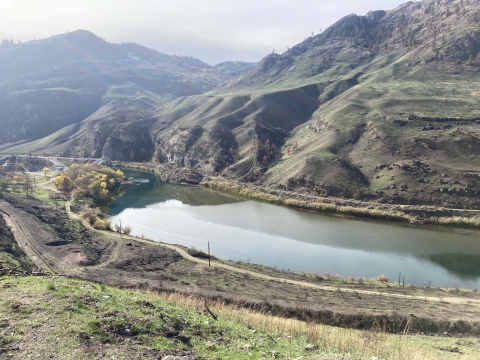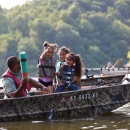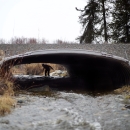States
WashingtonLooming over one of the most culturally significant sites in north central Washington, Similkameen Falls, the Enloe Dam has blocked salmon and steelhead from migrating into the upper portion of this watershed for over 100 years. Removing the dam will open up over 1,520 miles of cold-water habitat ideal for ESA-listed species including Upper Columbia Steelhead and Spring Chinook as well as non-listed Summer Chinook salmon and Pacific Lamprey, providing greater assurance that these species persist. In turn, increased salmon populations would also help the critically imperiled southern resident killer whales, as this is one of their major food sources.
Working together in partnership with the dam owner, Okanogan Public Utility District, the Confederated Tribes of the Coleville Reservation with support from the Upper and Lower Similkameen Indian Bands and other entities are leading the effort to explore the removal of this dam. A feasibility analysis is underway and expected to be completed in May 2025. Final decisions for the removal of the dam will be based upon the study’s conclusion. If a preferred alternative to remove Enloe Dam is determined to be feasible and is supported by stakeholders this project would restore natural river processes and provide significant ecological and community benefits, including improving ecosystem health, providing cultural resources for Tribal communities, and enhancing resilience to climate change climate change
Climate change includes both global warming driven by human-induced emissions of greenhouse gases and the resulting large-scale shifts in weather patterns. Though there have been previous periods of climatic change, since the mid-20th century humans have had an unprecedented impact on Earth's climate system and caused change on a global scale.
Learn more about climate change .
Project Quick Facts:
- Location: Washington
- Federal Investments to Date: $7,000,000
- Non-Federal Investments to Date: $4,000,000
- Total Restoration Costs: $50,000,000
- Type of Barriers: Dam
- Number of Barriers: 1
- Stream Miles Reopened: 1520
- Project Leads: Trout Unlimited, Confederated Tribes of the Colville Reservation
- Non-Federal Partners Include: Lower Similkameen Indian Band, Upper Similkameen Indian Band, Okanogan Public Utility District, American Whitewater, State of Washington, Columbiana, Local Residents
- Federal Agencies Invested to Date: U.S. Fish and Wildlife Service, National Marine Fisheries Service
Removing Barriers to Success
The current funding supports completion of the feasibility assessment, and – pending those results – future design, risk management, and permitting processes in preparation for future dam removal. Additional financial support of approximately $50 million is still needed to complete the final project phases including dam removal, sediment management, and habitat restoration.
The Importance of Transformational Fish Passage Projects
This project is one of over 70 grand-scale, community-centric restoration projects, identified by the Federal Interagency Fish Passage Task Force, that not only rejuvenate ecosystems but also bolster the climate resilience and economies of communities across the country. Learn more about these ground breaking projects in our Reviving Rivers, Reconnecting Communities story map.
The National Fish Passage Program combines technical expertise with a track record of success.
Implemented primarily through the Service's Fish and Wildlife Conservation Offices, the National Fish Passage Program provides financial and technical assistance to partners across the country. Since 1999, the program has worked with over 2,000 local communities, Tribes, and private landowners to remove or bypass over 3,400 barriers to fish passage fish passage
Fish passage is the ability of fish or other aquatic species to move freely throughout their life to find food, reproduce, and complete their natural migration cycles. Millions of barriers to fish passage across the country are fragmenting habitat and leading to species declines. The U.S. Fish and Wildlife Service's National Fish Passage Program is working to reconnect watersheds to benefit both wildlife and people.
Learn more about fish passage and reopen access to over 61,000 miles of upstream habitat for fish and other animals. Staff have expertise in fish migration and biology as well as financial, engineering, and planning assistance to communities, Tribes, and landowners to help them remove barriers and restore rivers for the benefit both fish and people.
Fish passage project proposals can be initiated by any individual, organization, government, or agency. However, proposals must be submitted and completed in cooperation with a Fish and Wildlife Conservation Office. (Please note that fish passage projects being used for federal or state compensatory mitigation or required by existing federal or state regulatory programs are not eligible for funding through the National Fish Passage Program.)
CONTACT A FISH PASSAGE COORDINATOR IN YOUR AREA TO GET STARTED.



